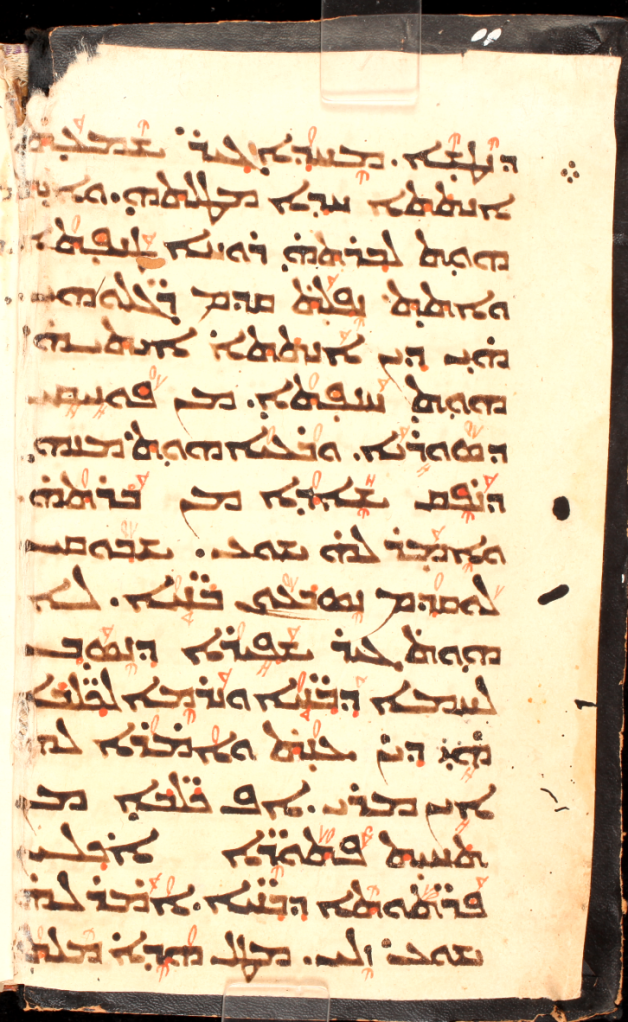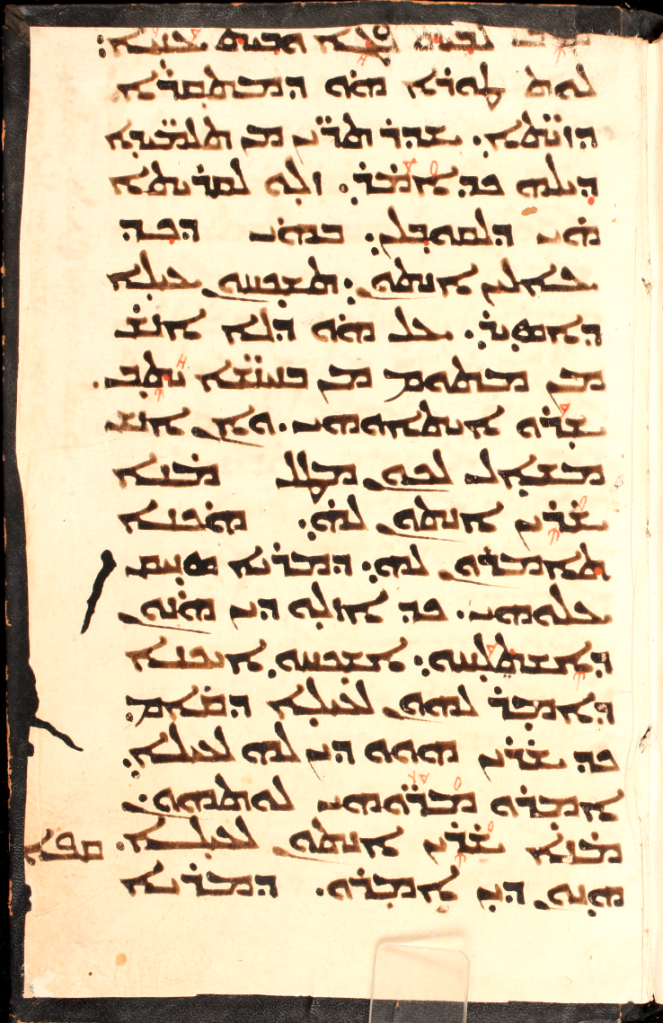Archive for April 2013
I recently posted an image of a pastedown in SMMJ 68 that came from an older Syriac Gospel lectionary. While still looking through the Jerusalem collection, I found another manuscript with pastedowns (at both front and back) from a Syriac Gospel-book.

Front pastedown of SMMJ 159

Back pastedown of SMMJ 159
The front pastedown has the Markan passage on the Syrophoenician woman (Συροφοινίκισσα; see Sebastiano Ricci’s painting here) from the last word of Mk 7:24 to halfway through 7:29 (again the Peshitta, as SMMJ 68), and the back has Lk 19:29 (beginning at the third word) to 19:34 (third word from the end), but this time in the Ḥarqlean. (The only difference between these texts and those in Kiraz’s Comparative Edition of the Gospels, the Peshitta of which is based on the edition of Pusey and Gwilliam, are at Mk 7:25 [w-ʾit here, but d-ʾit in the printed ed.] and 7:26 [Phoenicia spelled with final yod here, ālap in the printed ed.].) A comparison of these two extraneous pages from SMMJ 159 with the one from SMMJ 68 quickly reveals their origin in the same manuscript. Apparently this Gospel lectionary was at Saint Mark’s and no longer being used, probably too damaged to be of practical use, and apart from their original peers these three folios found new life in SMMJ 68 and 159. Like the former Jerusalem manuscript, the latter, according to a note in Arabic at the beginning, was repaired in October, 1910.
“A new critical edition of the Peshitta Gospels is needed, though the quantity of Peshita mss. renders this a formidable task.” So say R.B. ter Haar Romeny and C.E. Morrison in their entry on the Peshitta in GEDSH (p. 330). This manuscript, now much reduced and scattered, more folios of which might appear elsewhere lurking at the beginning or end of manuscripts at Saint Mark’s, adds to that quantity of Peshitta manuscripts: for Mark in the front pastedown of SMMJ 159, and for John and Matthew in the front pastedown of SMMJ 68. Not that these particular Syriac Gospel witnesses are all that unique or interesting, but they do serve as a reminder of the surprises manuscripts can offer. And, from a different angle, the script here has much to appreciate for its clarity and simplicity; it would make an easy exercise for beginning students to practice their reading skills.
Yesterday Alin Suciu posted a notice of a Bohairic Coptic leaf with some lines from the martyrdom of Macrobius that was recently found in a Syriac manuscript from Saint Mark’s Monastery in Jerusalem. He also mentioned the entry for that martyr in an Arabic synaxarion (published in PO 16.2, 190-193). The same entry also exists in the Gǝʿǝz synaxarion (published in PO 46.3, 304-309). The saint is commemorated on 2 Baramhāt (ⲡⲁⲣⲉⲙϩⲟⲧⲡ; see Crum 269a for the forms) in the Copto-Arabic synaxarion and 2 Mäggabit in the Gǝʿǝz synaxarion. (According to the Mensium tabulae in BHO, this date corresponds to Feb. 26 — “15 février” in the FT of PO 16 is an error; it is correctly given as “26 février” in the running title — but according to Colin’s table in PO 48.3, the Ethiopian date is Mar. 11.)
Alin notes that the new Coptic leaf has “part of the episode when Macrobius is boiled by the governor Armenius in grease, oil and pitch.” Saints’ lives sometimes exist in two lengths: a shorter notice in the synaxarion and a longer — sometimes considerably longer — one, which may be a vita (or sīra), collection of miracles, martyrdom account, an encomium, or a combination of these types, and which may circulate on its own, that is, not in a calendrical series like the synaxarion. Naturally, many more saints are listed in the synaxarion than have their own separate stories, and when more than one kind of hagiographic text exists for a particular saint, the episodes of the stories may vary more or less, whether in the same language or across languages. The Copto-Arabic and the Gǝʿǝz texts referred to above for Macrobius are essentially the same, but distinct from that of the longer encomium published by Hyvernat. Here is the beginning, with an ET of the Arabic and different readings in the Gǝʿǝz in brackets, of the synaxarion entries:
- في مثل هذا اليوم استشهد القديس الطوباني انبا مكراوي الاسقف كان هذا الاب من اهل اشمون خريسات من اكابرها فجعل اسقفا على مدينة نقيوس
- በዛቲ ፡ ዕለት ፡ ኮነ ፡ ቅዱስ ፡ ወብፁዕ ፡ አባ ፡ መክራዊ ፡ ኤጲስ ፡ ቆጶስ ፡ ሰማዕት። ዝንቱ ፡ ቅዱስ ፡ ኮነ ፡ እምሰብአ ፡ ሀገረ ፡ እስሙንዙራይስ ፡ እምልሂቃነ ፡ ዚአሃ ፡ እምደቡበ ፡ ግብጽ።ወተሰይመ ፡ ኤጲስ ፡ ቆጶሰ ፡ ላዕለ ፡ ሀገረ ፡ ነቂዮስ።
- On the same [G. “this”] day the blessed saint Anba Macrobius the bishop was martyred [G. “became a martyr”]. This father [G. “saint”] came from the chiefs of Ešmūn-Ḫarīsāt [G. ʾƎsmunzurayǝs] and he was made bishop over the city of Nikiu.
The synaxarion entries do not have the detail of the longer martyrdom text that partially survives in the Coptic leaf, and there is nothing about boiling the martyr. All they have to say about Armenius, governor of Alexandria (والي الاسكندرية, መኰንነ ፡ ሀገረ ፡ እስክንድርያ፡), and his tortures at this point is the following. The texts are formally different enough that they merit separate translations.
- فلما بلغ ارمانيوس ما يصنعه القديس من الايات امر ان يعذب بانواع العذاب بالعصر وبقطع الاعضاء وان يلقى للاسد الضارية وان يغرق في البحر وان يوضع في اتون النار وكان صابرا على هذا جميعه غالبا بقوة المسيح
- When news of the miracles the saint was doing reached Armenius, he commanded that he be tortured with various kinds of torture — by pressing and by cutting off limbs — that he be thrown to the savage lions, that he be drowned in the sea, and that he be placed in a furnace of fire. He was enduring all of this, conquering in the power of Christ.
- ወሶበ ፡ ሰምዐ ፡ ሄርሜንዮስ ፡ መኰንን ፡ በእንተ ፡ ተአምራት ፡ ዘገብረ ፡ ቅዱስ ፡ አባ ፡ መክራዊ ፡ ወአዘዘ ፡ ከመ ፡ ይኰንንዎ ፡ በዘዘዚአሁ ፡ ኵነኔ ፡ ወኰነንዎ ፡ በመንኰራኵራት ፡ ወመተሩ ፡ መልያልያቲሁ ፡ ወወገርዎ ፡ ለአናብስት ፡ መሠጥ ፡ ወአስጠምዎ ፡ ውስተ ፡ ባሕር ፡ ወወደይዎ ፡ ውስተ ፡ እቶነ ፡ እሳት። ወኮነ ፡ ቅዱስ ፡ ውስተ ፡ ኵሉ ፡ ኵነኔ ፡ መዋዒ ፡ ወጽኑዕ ፡ በኀይሉ ፡ ለእግዚእነ ፡ ክርስቶስ ፡ ወያነሥኦ ፡ ጥዑየ ፡ ዘእንበለ ፡ ሙስና።
- When Armenius the governor heard about the miracles that the holy Anba Macrobius had done, he commanded that he be tortured with various kinds of torture, and they tortured him with wheels, cut off his limbs, threw him to savage lions, drowned him in the sea, and put him in a furnace of fire, and the saint was prevailing in all of this torture, strong in the power of our Lord Christ, and he will raise him whole without decay.
In addition to the obvious text-critical interest that studying multiple versions of this or that hagiographic text might conjure, in the case of probably or definitely dependent texts, questions of translation technique might be asked (and, hopefully, answered). Those interested more in the narrative content of the stories and in their use in cult and devotion, too, have plenty of material for study in eastern Christian hagiography. And while there is already far more available across these languages than any one person could completely study, new pieces continue to appear, especially in previously unploughed fields of manuscript collections, as this Coptic leaf shows, a textual witness to a particular continuum that spans Coptic, Arabic, and Gǝʿǝz.
Thanks to Alin for his notice and discussion of the Coptic fragment!
Alin Suciu here discusses a Coptic leaf found in a Syriac manuscript from Saint Mark’s Monastery in Jerusalem that I came across a couple of weeks ago. Thanks to him for his remarks!
 Alin Suciu
Alin Suciu
A couple of weeks ago, Adam McCollum (Hill Museum & Manuscript Library, Minnesota) sent me the photograph of the recto of a paper leaf written in the Bohairic dialect of Coptic. The fragment was used as an endpaper in a ca. 15th-16th century Syriac codex from the Monastery of Saint Mark in Jerusalem (shelfmark no. 64). Adam came across the fragment while cataloguing the Syriac and Arabic manuscripts in this location.

Upon inspection, it appeared to me that the leaf preserves a portion from the Martyrdom of Macrobius (clavis coptica 0286). According to Coptic hagiography, Macrobius was a bishop of Nikiou (Pshati) martyred under Diocletian.[1] The new fragment recovered from the Syriac manuscript is important because only one other fragment from this martyrdom has survived. Thus, in 1949, the Bollandist Paul Devos published a similar Bohairic leaf from the Martyrdom of Macrobius, which…
View original post 488 more words

SMMJ 68, pastedown at end
Pages don’t always turn up where we expect them to. The image above is of a pastedown at the end of a Syriac liturigical manuscript (SMMJ 68), a Beth Gazo missing its beginning and end, dated 1580; according to a note on f. 186v, it was repaired in October, 1910 as part of Saint Mark’s collection, and it was probably at that time bound in the cover of an English Bible published much later by the British and Foreign Bible Society (see below)! (Incidentally, the original binder of the Bible was Watkins, as can be seen from the emblem at the top left of the photo above, on the inside of the original front cover; a search reveals other known copies of English Bibles bound by Watkins in the 19th century.) The page above is from an older (and prettier) manuscript, a Gospel lectionary containing Jn 5:29 and Mt 24:36-39 (Peshitta) in a clear Estrangela hand, including some diacritical marks and vowels. It is an iffy business attempting to date a single manuscript page, but this one might be from the 13th century.

The current cover of the book, originally a Bible from the British and Foreign Bible Society.
One of the most visually striking manuscripts, even though it is not very colorful, in the collection of the Near East School of Theology, Beirut, is AP 38, thanks to its drawings in the second part of the work. There are animals (including the human body), plants, mechanical diagrams, a map, and other figures. It is not an old book at all, but it deserves a facsimile edition for its unique visual presentations. An anonymous work, it was apparently translated from Turkish, which version itself was translated from an English book (cf. J.W. Pollock, “Catalogue of Manuscripts of the Library of the Near East School of Theology,” Near East School of Theology Theological Review 4 [1981]: 69). Below is one example of the several diagrams (pt. 2, p. 11):

NEST AP 38, pt. 2, p. 11
The caption reads:
hāḏihi ṣūratu ṭurumbā [sic] ‘l-māʾi allaḏī tanšulu ‘l-māʾa min al-baḥri wa-tūṣiluhu ilá ‘l-amākini ‘l-baʿīdati ka-ma tarāhā marsūmatan hākaḏa hāhunā
This is a picture of a water-pump that takes water from the sea and conducts it to faraway places, as you see drawn here.
(For ṭurumba/ṭurumbā, cf. Italian trompa, Turkish tulumba.)





